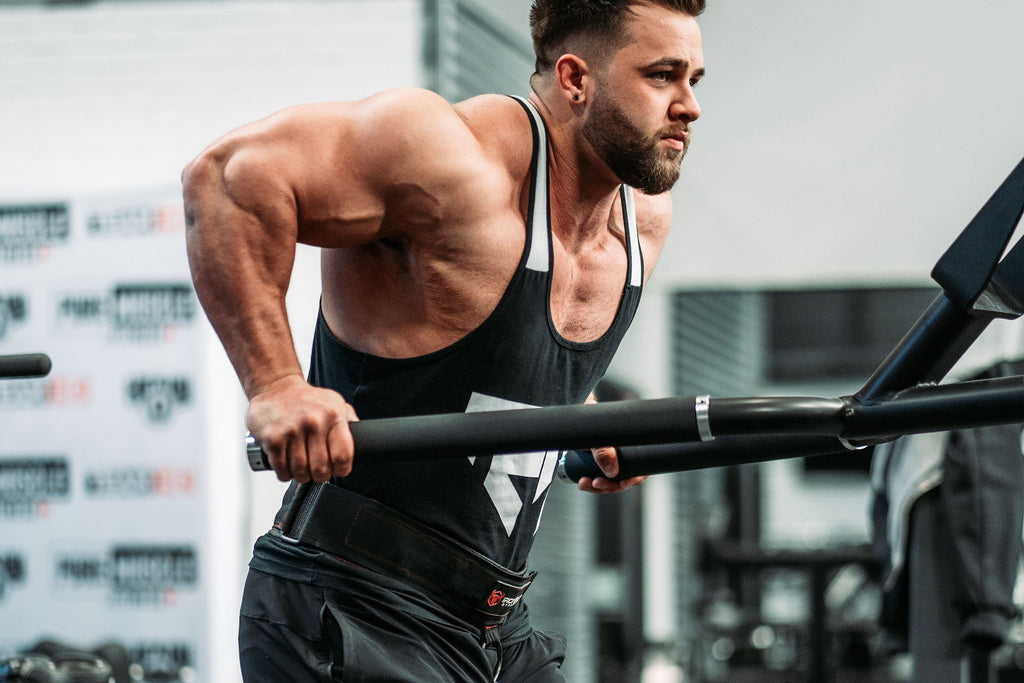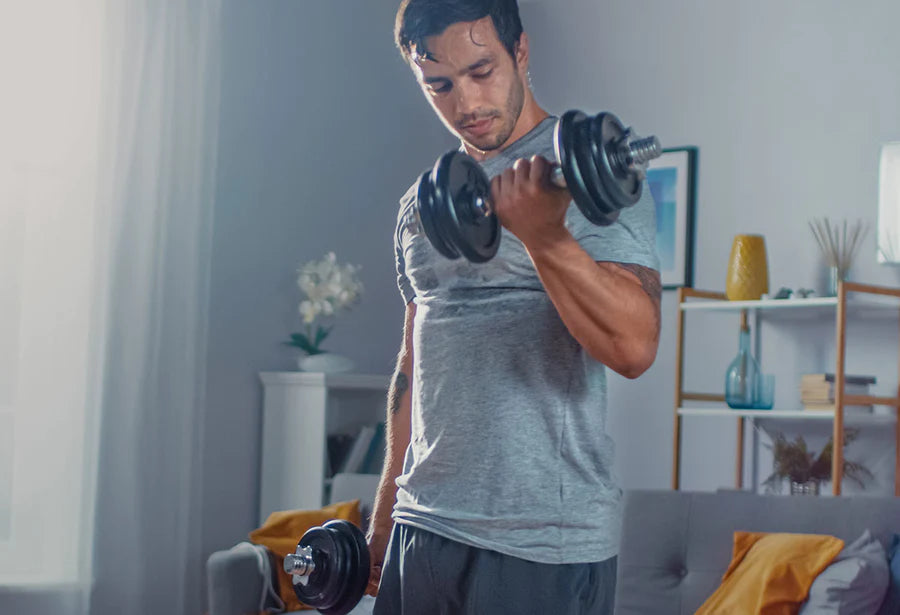Studies reveal how to burn fat and build muscle

Enhance your lifestyle.
It seems like every other week; there's a fitness article being published on major blogs or websites that promises to work miracles for weight loss. Yes, we see the irony here. Here's the thing: Many of these articles aren't based on real science unless you count bro science as a valid form of research. Relying on straightforward, scientifically proven facts is the best way to change your daily habits to see results.
When it comes to burning fat, a relatively recent study has been the center of attention as its results promise to burn fat while building muscle. Let's break down the study's results and how to use this information to help you achieve your weight loss and muscle-building goals.
THE STUDY: BURN FAT AND BUILD MUSCLE
A quick heads-up: The study's results may not seem like some new revelation for those who are no strangers to weight loss and muscle building. However, this study is significant because the researchers shed light on how the subjects lost weight. Every other week, a fitness article is published on major blogs or websites that promise to work miracles for weight loss. Yes, we see the irony here. Here's the thing: Many of these articles aren't based on real science unless you count bro science as a valid form of research. Relying on straightforward, scientifically proven facts is the best way to change your daily habits to see results.
When it comes to burning fat, a relatively recent study has been the center of attention as its results promise to burn fat while building muscle. Let's break down the results of the research and how you can use this information to help you achieve your weight loss and muscle-building goals.
ROLE OF CALORIES
Right now, you might be asking: "What does 'fewer calories than they required' mean?" The young subjects performed an intense form of exercise six days per week. Naturally, their bodies are going to demand a certain number of calories for growth and recovery. On average, that number would range between 3,000 to 4,000 calories, depending on body type, fitness experience, and exercise intensity. The researchers calculated the number of calories each subject was supposed to receive but only provided them with sixty percent of what their bodies needed. Why is this important?
For the longest time, we've been told that if you aren't getting the calories you need, your body should enter a state of catabolism or muscle breakdown. That's where your body starts using muscle tissue as fuel. But this is where the study gets interesting; despite providing the subjects with sixty percent of their required calories, the researchers adjusted one macronutrient: protein.
PROTEIN SAVES THE DAY
Group A was given 2.4 grams of protein per kilogram of body weight, while Group B received 1.2 grams of protein per kilogram of body weight. For example, let's say you weigh 72 kilograms (159 pounds):
If you were in Group A: 72 (kg) x 2.4 (grams of protein) = 172.8
- You would have received 173 grams of protein per day from various whole food and supplement sources.
If you were in Group B: 72 x 1.2 = 86.4
- You would have received 87 grams of protein per day
Despite the high-end workload that both groups had to perform, the protein made all of the difference in this study. Not only did Group A hold on to their muscle, but the subjects gained about one kilogram or a little more than two pounds of muscle mass. What's more, Group A lost four kilograms of body fat.
Even though Group B had a lower amount of protein, they still managed to avoid muscle catabolism, but they didn't see nearly the same level of positive results that Group A did. (1)
HOW TO MAKE THIS STUDY WORK FOR YOU
To sum up the study: Large amounts of dietary protein in combination with a reduced calorie diet and intense exercise program will support fat loss and muscle building simultaneously.
Sounds great, but what about realistic actions you can take right now to start supporting more fat-burning and muscle-building? Here's beginner-friendly and experienced lifters plan that you can adopt to kickstart your progress.
BEGINNER'S GUIDE TO BURN FAT AND BUILD MUSCLE
Reviewing the study, you'll see that exercise was half the foundation. The subjects used compound exercises with short rest breaks. Both of these have been scientifically shown to burn more calories while promoting muscular hypertrophy or growth. (3)
Related: 8 Week Hypertrophy Training Program
With that said, you'll want to focus on the classic compound exercises that utilize the greatest number of muscle groups, burn the most calories, trigger the highest degree of fat loss, and stimulate the highest production of fat-burning hormones:
- Squats
- Bent Over Row
- Deadlifts
- Bench Press
- Clean and Press
Don't forget that some of these compound exercises may require some light fitness equipment, such as a squat pad or wrist wraps.
You'll also need to know the proper set of acute variables. For every exercise, you'll want to perform the following:
- 2 to 3 sets
- 8 to 15 repetitions
- 60 to 90 second rest breaks
- 2 to 4 times per week
Cardiovascular training also played an important role during the study. The study used sprints as the ideal form of cardiovascular training for beginners. We recommend a light jog for 50 seconds, then sprinting for 10 seconds. Repeat this pattern no less than 5 times.
BEGINNER'S BURN FAT AND BUILD MUSCLE WORKOUT PROGRAM
Putting it all together, here is a full-body workout program that you can use:
MONDAY AND THURSDAY:
- Squats: 3 sets of 8 to 15 repetitions
- Bent Over Row: 3 x 8 to 15 repetitions
- Deadlifts: 2 x 8 to 15 repetitions
- Bench Press 2 x 8 to 15 repetitions
- Clean and Press 2 x 10 to 15 repetitions
Pro Tip: When deadlifting, use an iron wedge to change the plate. This handy tool makes it easier and safer to load and unload weights, saving you time and effort.
TUESDAY AND FRIDAY:
- Sprints: 50-second jog / 10-second sprint – Repeat 5 to 10 times
ADVANCED GUIDE TO BURN FAT AND BUILDING MUSCLE
For the experienced weightlifter, it may be beneficial to take a different approach. You'll be using the same exercises but at different intervals, and your overall training volume will be greater:
- Monday: Resistance Training A
- Tuesday: Resistance Training B
- Wednesday: Cardiovascular Training
- Thursday: Resistance Training A
- Friday: Resistance Training B
- Saturday: Cardiovascular Training
- Sunday: REST
Here are how your resistance training workouts will be split up:
Resistance Training A
- Squats
- Bent Over Row
- Clean and Press
Resistance Training B
- Deadlifts
- Bench Press
- Overhead Press
As far as cardiovascular training, you can choose between sprints and high-intensity interval training. H.I.I.T. uses a series of bodyweight exercises that are performed in rapid succession with no break. Once you complete one set of each movement, then you rest for 2 minutes before beginning again. H.I.I.T. is another scientifically proven method to burn fat and build muscle. (4)
ADVANCED BURN FAT AND BUILD MUSCLE WORKOUT PROGRAM
A quick note about the acute variables: The fewer repetitions you perform, the more weight you need to use. Naturally, the more repetitions you complete, the lighter the weight should be.
Resistance Training A:
- Squats: 4 sets of 6 to 12 repetitions
- Bent Over Row: 4 x 6 to 12 repetitions
- Clean and Press: 3 x 6 to 12 repetitions
Resistance Training B:
- Deadlifts: 4 x 6 to 12 repetitions
- Bench Press: 4 x 6 to 12 repetitions
- Overhead Press: 3 x 6 to 12 repetitions
Cardiovascular Training:
- Sprints (as detailed above) or this H.I.I.T. Workout:
- Jumping Jacks: 15
- Push-up: 15
- Pull-up: 10
- Bodyweight Squats: 20
- Jumping Lunges: 15
- Burpees: 10
- Plank: Failure
Pro Tip: Changing up your workouts, such as incorporating an incline bench, can prevent your muscles from adapting to the same movements, ensuring they work harder and burn more calories. Always use spotter arms attached to a squat rack or power cage for added safety. If you gym partner isn't available, these tools are essential to ensure you can train safely and confidently.
TWEAKING YOUR DIET
Cut Calories: As you saw in the study, cutting calories is a must. First, calculate your calories or how much you should be eating every day based on the workouts above. Next, only consume 60% to 70% of that number of calories.
Meal Timing: To minimize those hunger pangs, you have two options depending on your preference: You can choose to eat every 2 to 3 hours. The idea is to eat smaller meals many times throughout the day so that your stomach never has a chance to start growling.
The other option – and the one we recommend – is using intermittent fasting. This is when you fast or avoid food and calorie-based beverages for 16 hours, then follow that up with an eight-hour feeding window. This method has been shown to be extremely effective for fat loss and muscle building. Most people stop eating at 8 p.m. and then resume their windows at noon the next day. (5)
Eat More Protein: Be sure to include plenty of lean proteins in your diet, including chicken breasts, lean pork cuts, and salmon. You should also invest in a quality protein supplement to make sure you hit your protein mark. Try drinking a shake first thing in the morning and at least once more during the day. Supplements should not be more important than food.
Hunger Pangs: Vegetables are nutritious and low in calories. Not to mention they are very filling. Don't limit the amount of vegetables that you eat. Focus on cutting the calories elsewhere. Also, be sure to drink plenty of water, especially after an intense workout.
BURN FAT AND BUILD MUSCLE GROCERY LIST
Don't spend hours in the grocery store deciding the healthiest things to buy. Use our grocery list that's friendly for both meat-eaters and vegetarians:
LEAN ANIMAL PROTEINS
- Chicken
- Brown eggs
- Lean pork
- Grass-fed beef
- Plain Greek yogurt
PLANT-BASED PROTEINS
- Lentils
- Brown / Black rice
- Legumes
- Oatmeal
- Quinoa
PROTEIN SUPPLEMENTS
- Whey protein blend (1 to 3 servings per day)
- Plant-based protein blend
VEGETABLES
- Broccoli
- Cauliflower
- Carrots
- Kale
- Spinach
- Zucchini
FRUITS
- Apples
- Blueberries
- Oranges
- Bananas
NUTS / SEEDS
- Almonds
- Cashews
- Chia seeds
- Coconut Oil
- Pumpkin seeds
- Walnuts
SUPERFOODS
- These items aren't required, but if you want to give your health and recovery an extra boost, here are some superfoods to consider:
- Cacao nibs/powder
- Goji berries
- Hemp seed powder
- Maca powder
STAY CONSISTENT TO BURN FAT AND BUILD MUSCLE
Regardless of the road you take, consistency is key to success. Be sure that you complete your workouts when scheduled and take active measures to reduce your caloric intake safely.
Once you've completed these programs for six to eight weeks, take a look at your progress and consider changing your acute variables. For example, you can use more weight or increase the intensity of the movement. You can also add more sets, repetitions, or exercises. As a beginner, you can try the advanced lifting program.
The only thing as important as consistency is change. If your body gets used to the program that you're using, that's when you might reach a plateau. Stay focused and stay hungry. That'll lead you to success.
HAVE YOU TRIED TO BURN FAT AND BUILD MUSCLE SIMULTANEOUSLY?
What type of results did you experience? Have you tried our program from above? Let us know what you think on our Facebook. Better yet, have a picture of yourself performing our Burn Fat and Build Muscle Workout. Tag us on Instagram so we can share it.
REFERENCES
- Thomas M Longland, Sara Y Oikawa, Cameron J Mitchell, Michaela C Devries, and Stuart M Phillips. Higher compared with lower dietary protein during an energy deficit combined with intense exercise promotes greater lean mass gain and fat mass loss: a randomized trial. American Journal of Clinical Nutrition, January 2016 DOI: 10.3945/ajcn.115.119339
- Pasiakos SM, Cao JJ, Margolis LM, Sauter ER, Whigham LD, McClung JP, Rood JC, Carbone JW, Combs GF Jr, Young AJ. Effects of high-protein diets on fat-free mass and muscle protein synthesis following weight loss: a randomized controlled trial. FASEB J. 2013 Sep;27(9):3837-47. doi: 10.1096/fj.13-230227. Epub 2013 Jun 5.
- Kak H-B, Cho S-H, Lee Y-H, et al. A Study of Effect of the Compound Physical Activity Therapy on Muscular Strength in Obese Women. Journal of Physical Therapy Science. 2013;25(8):1039-1041. doi:10.1589/jpts.25.1039.
- Perry CG, Heigenhauser GJ, Bonen A, Spriet LL. High-intensity aerobic interval training increases fat and carbohydrate metabolic capacities in human skeletal muscle. Appl Physiol Nutr Metab. 2008 Dec;33(6):1112-23. doi: 10.1139/H08-097.
- Derave W1, Mertens A, Muls E, Pardaens K, Hespel P. Effects of post-absorptive and postprandial exercise on glucoregulation in metabolic syndrome. Obesity (Silver Spring). 2007 Mar;15(3):704-11.


